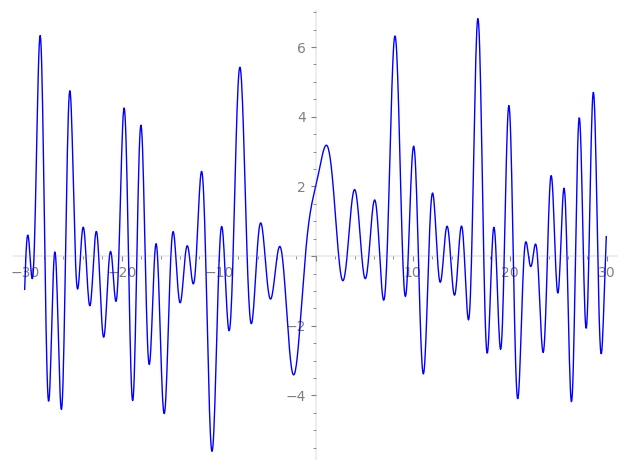| L(s) = 1 | + 1.35·2-s + (0.0933 + 0.161i)3-s − 0.160·4-s + (1.08 − 1.88i)5-s + (0.126 + 0.219i)6-s + (−1.43 − 2.49i)7-s − 2.93·8-s + (1.48 − 2.56i)9-s + (1.47 − 2.55i)10-s + (1.47 − 2.55i)11-s + (−0.0149 − 0.0259i)12-s + (−0.5 + 0.866i)13-s + (−1.95 − 3.38i)14-s + 0.406·15-s − 3.65·16-s + (0.832 + 1.44i)17-s + ⋯ |
| L(s) = 1 | + 0.959·2-s + (0.0539 + 0.0933i)3-s − 0.0802·4-s + (0.487 − 0.843i)5-s + (0.0516 + 0.0895i)6-s + (−0.543 − 0.942i)7-s − 1.03·8-s + (0.494 − 0.855i)9-s + (0.467 − 0.808i)10-s + (0.445 − 0.770i)11-s + (−0.00432 − 0.00749i)12-s + (−0.138 + 0.240i)13-s + (−0.521 − 0.903i)14-s + 0.105·15-s − 0.913·16-s + (0.201 + 0.349i)17-s + ⋯ |
\[\begin{aligned}\Lambda(s)=\mathstrut & 403 ^{s/2} \, \Gamma_{\C}(s) \, L(s)\cr =\mathstrut & (0.412 + 0.910i)\, \overline{\Lambda}(2-s) \end{aligned}\]
\[\begin{aligned}\Lambda(s)=\mathstrut & 403 ^{s/2} \, \Gamma_{\C}(s+1/2) \, L(s)\cr =\mathstrut & (0.412 + 0.910i)\, \overline{\Lambda}(1-s) \end{aligned}\]
Particular Values
| \(L(1)\) |
\(\approx\) |
\(1.68372 - 1.08583i\) |
| \(L(\frac12)\) |
\(\approx\) |
\(1.68372 - 1.08583i\) |
| \(L(\frac{3}{2})\) |
|
not available |
| \(L(1)\) |
|
not available |
\(L(s) = \displaystyle \prod_{p} F_p(p^{-s})^{-1} \)
| $p$ | $F_p(T)$ |
|---|
| bad | 13 | \( 1 + (0.5 - 0.866i)T \) |
| 31 | \( 1 + (4.88 + 2.66i)T \) |
| good | 2 | \( 1 - 1.35T + 2T^{2} \) |
| 3 | \( 1 + (-0.0933 - 0.161i)T + (-1.5 + 2.59i)T^{2} \) |
| 5 | \( 1 + (-1.08 + 1.88i)T + (-2.5 - 4.33i)T^{2} \) |
| 7 | \( 1 + (1.43 + 2.49i)T + (-3.5 + 6.06i)T^{2} \) |
| 11 | \( 1 + (-1.47 + 2.55i)T + (-5.5 - 9.52i)T^{2} \) |
| 17 | \( 1 + (-0.832 - 1.44i)T + (-8.5 + 14.7i)T^{2} \) |
| 19 | \( 1 + (-3.39 - 5.87i)T + (-9.5 + 16.4i)T^{2} \) |
| 23 | \( 1 - 4.72T + 23T^{2} \) |
| 29 | \( 1 + 1.93T + 29T^{2} \) |
| 37 | \( 1 + (0.166 + 0.287i)T + (-18.5 + 32.0i)T^{2} \) |
| 41 | \( 1 + (0.561 - 0.972i)T + (-20.5 - 35.5i)T^{2} \) |
| 43 | \( 1 + (-2.62 - 4.54i)T + (-21.5 + 37.2i)T^{2} \) |
| 47 | \( 1 + 8.43T + 47T^{2} \) |
| 53 | \( 1 + (-5.94 + 10.2i)T + (-26.5 - 45.8i)T^{2} \) |
| 59 | \( 1 + (-3.23 - 5.59i)T + (-29.5 + 51.0i)T^{2} \) |
| 61 | \( 1 - 5.91T + 61T^{2} \) |
| 67 | \( 1 + (5.73 - 9.93i)T + (-33.5 - 58.0i)T^{2} \) |
| 71 | \( 1 + (0.218 - 0.377i)T + (-35.5 - 61.4i)T^{2} \) |
| 73 | \( 1 + (-2.33 + 4.04i)T + (-36.5 - 63.2i)T^{2} \) |
| 79 | \( 1 + (-6.84 - 11.8i)T + (-39.5 + 68.4i)T^{2} \) |
| 83 | \( 1 + (3.91 - 6.77i)T + (-41.5 - 71.8i)T^{2} \) |
| 89 | \( 1 - 4.45T + 89T^{2} \) |
| 97 | \( 1 + 1.01T + 97T^{2} \) |
| show more | |
| show less | |
\(L(s) = \displaystyle\prod_p \ \prod_{j=1}^{2} (1 - \alpha_{j,p}\, p^{-s})^{-1}\)
Imaginary part of the first few zeros on the critical line
−11.35094415136139511756288836579, −9.941614686609210642947399788072, −9.421258329306774342230708397162, −8.521923947031241840161898884865, −7.06958015599774504808832074381, −6.07195178456528597588380868478, −5.22564122735155324182882726269, −3.97657736903749057198568516328, −3.45200663145244014157335580653, −1.07438691195020510448966930793,
2.36829463064330519966885012285, 3.22946955578380940454790597860, 4.74697773939748819982877836944, 5.46611664515514538339214088747, 6.60050975300531248302495143426, 7.34534690654072487716668135194, 8.962719317101194259789700417232, 9.535364901505325667002273397389, 10.58433170996663962568295648907, 11.64627466464763148896221768157

